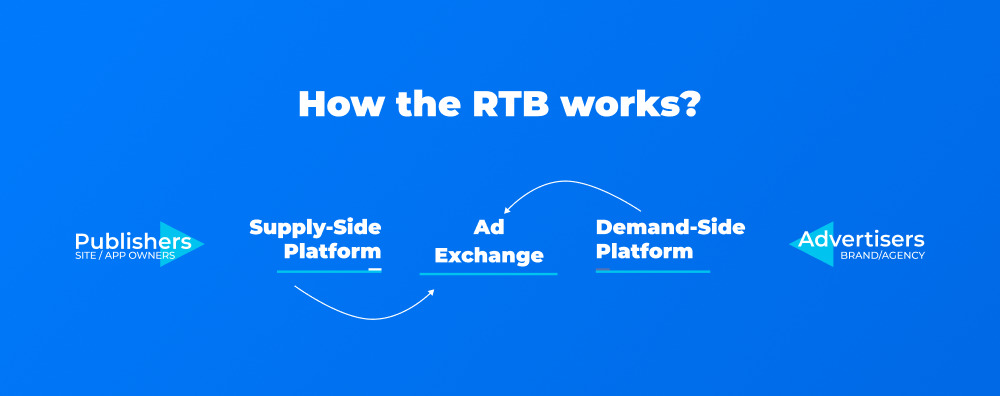New technologies of Internet advertising have opened extra opportunities. Programmatic tools brought many benefits – from controlling what audience the ad is demonstrated to the simplicity of the whole publishing process.
The names in the title are widely spread terms in the digital advertising industry. The distinctive features are so subtle that they need to be clarified even for many experts in the field. Both approaches have a lot in common. These methods use multi-channel purchase models, user behavior parameters, and quick processing.
Looking ahead, programmatic advertising is a broader concept. RTB is one of its types and can be part of it. But let’s focus on each idea separately and delve into the subject to understand how these systems work.
Table of Contents
Programmatic Advertising Definition
A general definition of the concept usually revolves around purchasing and selling internet marketing space. But this is a very rough explanation. Ad exchanges, SSPs, and DSPs lead the market today. They are the link between people wanting to advertise something and those ready to publish these ads. Both parties willingly use computerized platforms to achieve better results and make the transaction faster.

The key to a quick deal is algorithmic software. This tool speeds up the whole process, reducing the duration to seconds. But that’s not all. The base system considers the target audience’s demographics, user behavior, age, and other criteria. This analysis of potential customers significantly improves conversion. And it means a mutual benefit for all parties.
How Does Programmatic Ad Buying Work?
Programmatic media-buying means using specialized software and algorithms to automatically buy digital ad space, such as display ads, banners, and videos.
There are different ways to do programmatic media-buying:
- Programmatic direct. Advertisers and publishers agree to the media campaign’s terms and use software to manage the delivery and reporting of the ads.
- Real-time bidding (RTB). Advertisers can buy ad space one impression at a time through auctions on the open market. Any advertiser can bid for ad space on a publisher’s website.
- Private marketplace (PMP). This is a form of RTB, but the ad inventory is only available to selected advertisers, usually for premium sites and large brands.
Programmatic media-buying is more efficient than traditional methods because it automates the process and deals with increasing digital channels and publishers. What makes programmatic even more powerful is the use of data about customer behavior, geography, time of day, and other factors. This data helps advertisers target specific audiences more effectively with their ads.
What Is RTB?
Considering everything we said previously, it is easier to get the meaning of RTB. Real-time bidding is a part and type of programmatic advertising. What is its main idea? Advertisers compete for valuable ad placement in an online auction. The essential advantage is that one may pick where impressions are served. All procedures are automated, and no human participation is required.

Let’s take a closer look at how RTB works.
- First, a user clicks on a website that has ad space available.
- Then, the website owner puts the ad impression up for auction via a supply-side platform (SSP).
- Advertisers then bid on the ad impression using a demand-side platform (DSP).
- The highest bidder wins the auction, displaying their ad on the website for the user to see.
- If the user is interested and clicks on the ad, they may convert and complete a desired action.
- Despite the various steps involved, this process occurs in hundreds of milliseconds, thanks to algorithms and analytics that calculate competing bids and determine the most cost-effective option.
- For instance, suppose the user who clicked on the website is an ideal potential customer for your ad based on their online browsing history and profile. In that case, the bid for your ad impression will likely be higher to maximize the chances of conversion.
So RTB is a name for a process type during which you can buy needed media space on the most favorable terms. Participants set their bet prices. All steps are transparent and clear. A user is provided with a report at the end of each campaign. So an advertiser has all the tools for future improvements.
Similar And Distinctive Features
Both systems automate the acquisition and sale of advertisements. Both are internet tools that connect ad buyers and sellers. That is all they have in common. Here come the differences.

Programmatics is a broader concept. This system includes many ways to achieve desired targets. In addition to sales at the auction, transactions can be conducted directly with the site. The system offers a choice between having a guarantee for impressions number (Preffered Guaranteed) or no guarantees (Preffered Deal).
RTB is merely one kind of programmable ad purchase, which is part of the Programmatic. This method is always based on an auction. In RTB, the tender is not about an advertising place but about showing particular materials to specific visitors. The user pays for ad impressions. And one can be sure it will be shown to specific target audiences.
To Sum Up
Programmatic and real-time bidding (RTB) are often confused. These concepts have a lot in common, but in fact, they are different. The first one is a system uniting many methods of placing ads. RTB is just one of them.
All mentioned tools help automate the purchase of promotional spaces. There is no possibility of human mistakes. Another advantage is less of a routine associated with tracking sites and an opportunity to improve performance by analyzing reports.
Our tech staff and AdOps are formed by the best AdTech and MarTech industry specialists with 10+ years of proven track record!

This Article's Ad Tech terms

